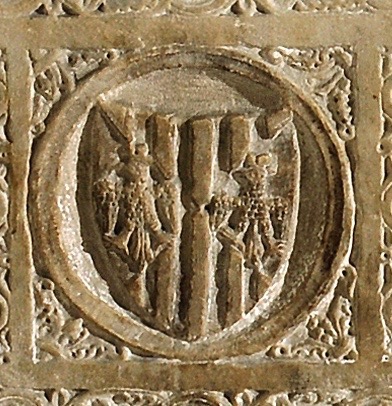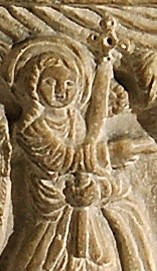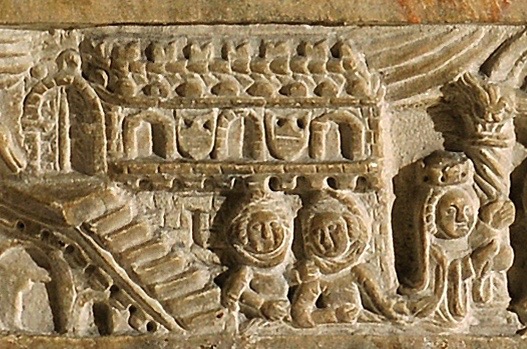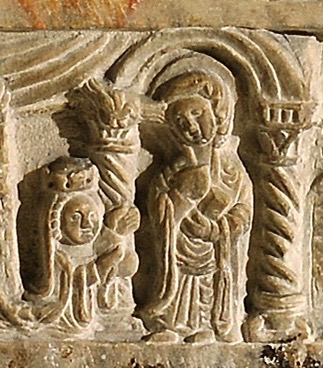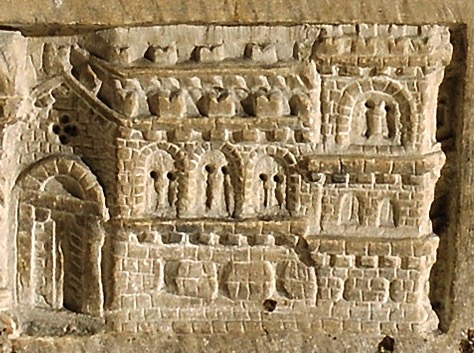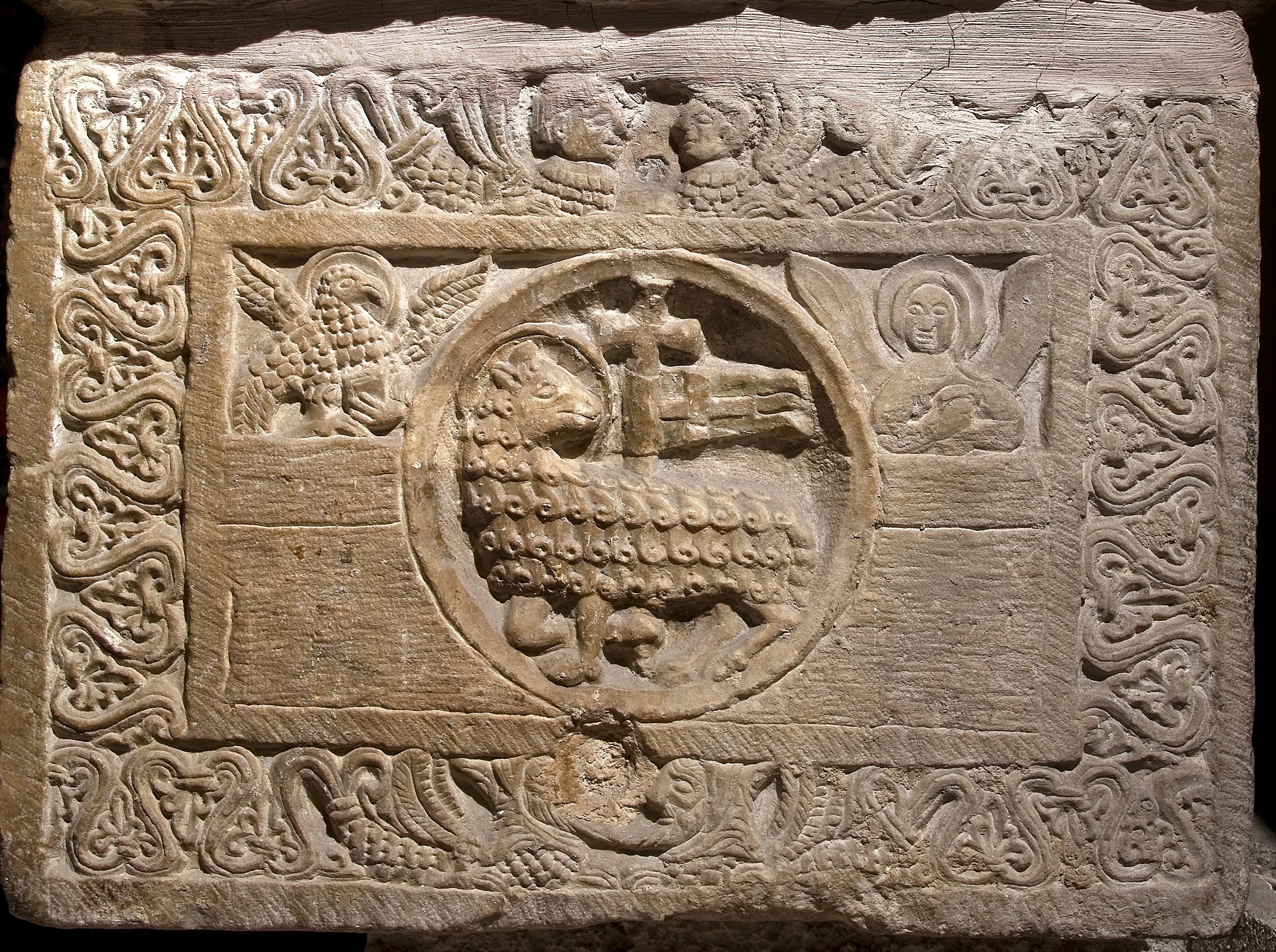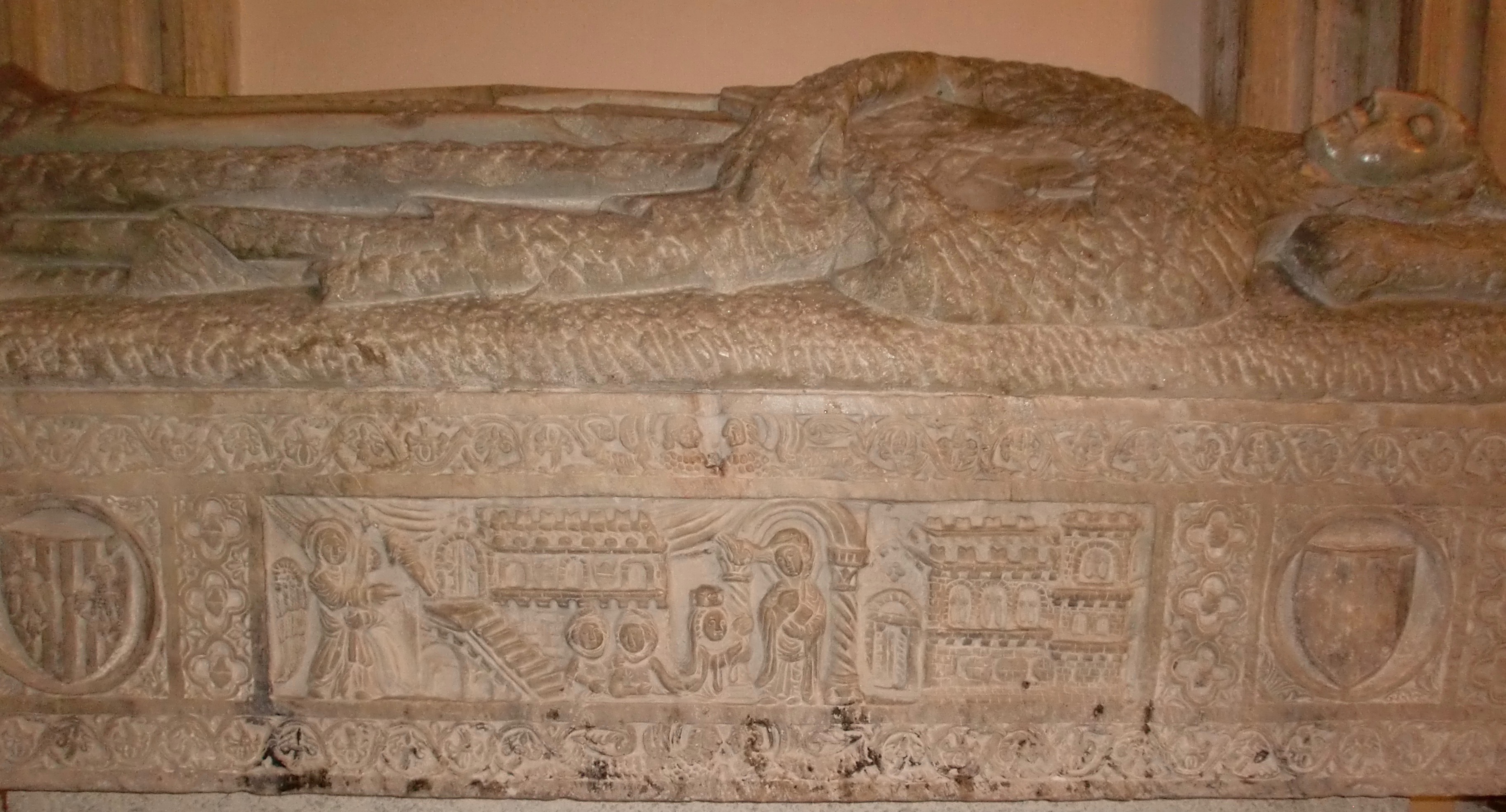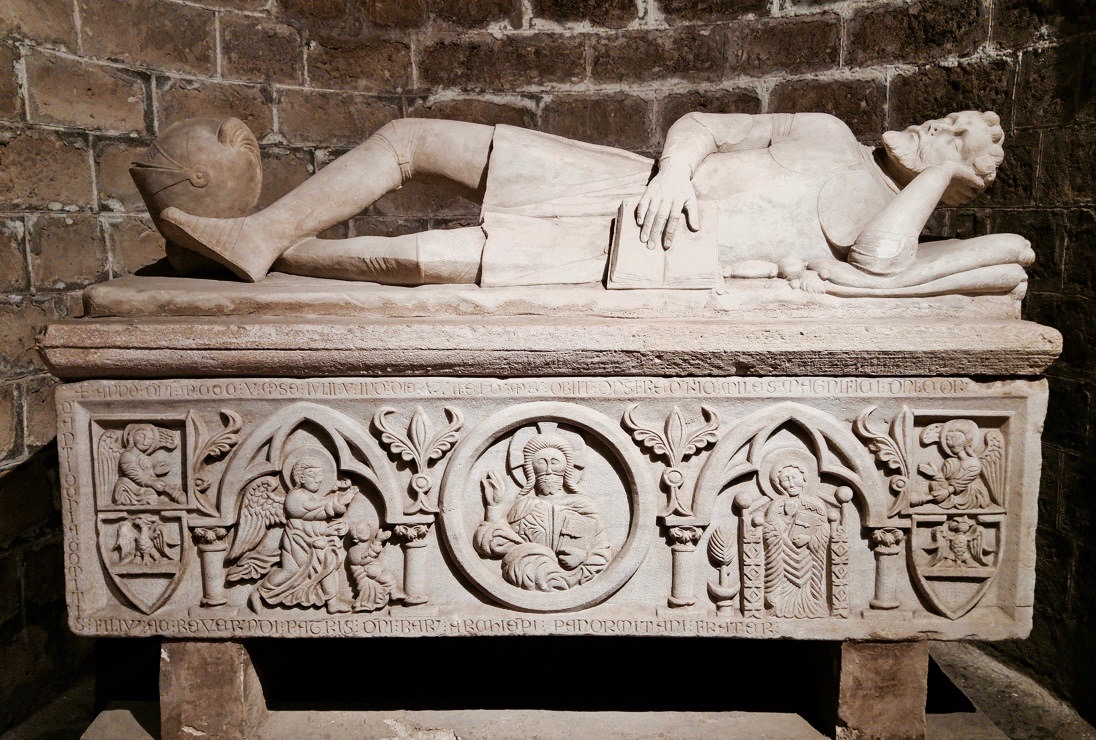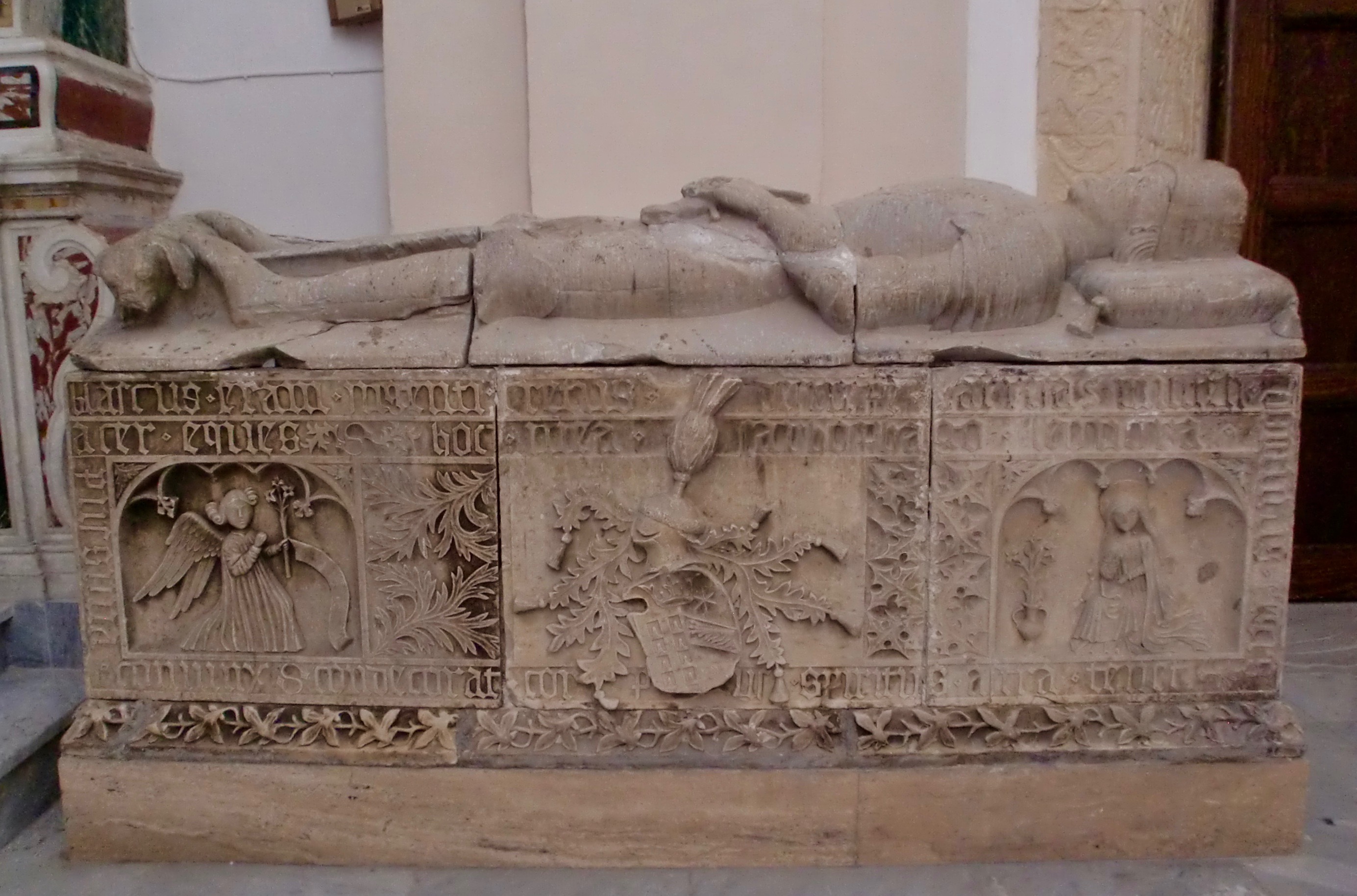Name
Coffin of the sarcophagus of the queen Maria of Sicily (†1401)
Chronological framework
Late fourteenth century
Description of the monument
The coffin of the sarcophagus of the tomb known as “il sarcofago di Costanza di Aragona” it’s a marble piece that measures 2 m long × 44 cm high × 62 cm wide. The front and the right side are sculpted in bas-relief.
The front gives the impression of being a stony tapestry worked with quick and easy strokes. On the outermost part or border, the ornamental drawing is repeated following the undulations of some stems that intersect and enclose a kind of cocoon or peduncle shaped like a palm. Each of these blooms is within the circular spaces formed by the undulating branches. Thus, the compositional elements are repeated every two blooms: an artichoke or fleur-de-lis that grows from a base that intersects with the upper circle that encloses it. Then it is followed by an inverted plant that comes out of the circle created by itself and by the one next to it. The composition starts from the two figures that occupy the central parts, which also appear on the sculpted side of the coffin. They could be male sphinxes-mermaids since vertical wings emerge from their back and their entire body is covered with scales. The two seem to have the hind limbs turned into a fishtail, but while the one on the right has something like a hand, the one on the left has a clawed bird’s foot. Although they have a masculine physiognomy, it could be those feminine beings that accompany the deceased to the underworld or, rather, to the island of the blessed. There is a progression of a sphinx and twelve plant circles. The one that makes thirteen is already part of the vertical border, which has six elements. So, it is balanced in 12×6×12 + 12×6×12.
The inner box is well marked by a strip of 1 or 2 centimetres wide. This rectangle of approximately 1.85 meters is divided by four vertical stripes. Each of these vertical separations has three quatrefoils that seem to enclose small heraldic shields, which could be symbols of the citizen identity of Catania (VITOLO, 2019). The 12 shields are identical. Carved horizontally, in the upper partition or head of the shield, a silhouette that could be a mountain can be guessed. They appear to be the same ones we see on the façade of the building behind the maidens. It could be the shield of L’Empresa de la Corretja (VILADOMIU, 2021). As in the rest of the sarcophagus, not even a millimetre is left empty. It is the horror vacui of Islamic and Byzantine decoration, where western and eastern art merge.
The shield – rectangular ogival- located on the right, within a circle inscribed in a square of approximately 25 cm, is that of the kingdom of Aragon or the four bars of the House of Barcelona. On the other side and in absolute symmetry, is the party per saltire shield coat of arms of the kings of insular Sicily. With these two elements it seems clear that the person who was buried there was the daughter of a Sicilian king and a queen of Catalonia / Aragon.
In the central part we find a “naive” bas-relief that rather seems one of the many paintings that can still be seen on the beams of the main hall of the palace of Chiaramonte – Steri of Palerm (NOBILE & SCIASCIA, 2015; CARCHIOLO, 2015) or in the illustrations of some prayer books. The narration is very clear: an Annunciation that is chaired by the person who is going to be buried inside, the daughter of a Sicilian king and a Catalanaragonese queen.
The description of this central box of more than one meter long will begin from the left of the image:
The first thing we find is a naive archangel Gabriel with a huge wing, a well-shaped nimbus and a huge sceptre or staff topped with some kind of cross. The archangel, who is moving towards the centre of the image, is covered with thick clothes. The tunic and cape have many folds, which gives them a lot of movement and naturalness. With his left hand, where the folds of clothing are centralized, he holds this pastoral staff, while with his right hand he points towards the virgin, as if he were speaking to her. Behind him the sky opens in a series of parallel semicircular shape lines from which the enormous hand of God comes out. The index and middle fingers of the Angel are marking the path that the hand of God has opened saying: “Rejoice you, who are full of grace, the Lord is with you“. This is the first moment of the Annunciation and the mystery of heaven that comes to Earth from the hand of God.
A little further to the right we come to the part of the narration of the events of the court life. We find in the middle of the scene a small and timid image, the queen, accompanied by two maidens located between the angel and the midpoint of the image. Behind these two ladies we see a civil building with a large semi-open door at the end of a staircase. The building has three windows, one of them clearly with a semi-circular arch, and a roof with tiles and battlements. Between each window there are some shields, possibly similar to those of the vertical stripes, and below this, there is a horizontal line of ashlars. Still below this line there is an arrowslit, therefore it is a fortress. It could be an imaginary representation of the imposing Norman castle of Catania, which was on the top of a hill near the sea: the castle Ursino. The daughter of King Frederic IV was born in this fortress and lived a good part of her life in it. The construction is similar to that of the Steri palace in Palermo during the fourteenth century (NOBILE & SCIASCIA, 2015) or to the missing Jury Building in Catania that was located near the cathedral (CARCHIOLO, 2015; VITOLO, 2019). Could it be the building where the 12 Knights of l’Empresa de la Corretja met?
The two maidens are dressed in long-sleeved shirts covered by street dresses, with wide half-sleeves (gonella and cota ardia). They are trimmed with veils that partially cover the hair and pass under the chin forming a chin rest (mentonera) (AYMERICH, 2018). One of the maidens seems to be leaning on a railing while the other lays the left hand on her shoulder. The figures are not at all static; they seem to be talking to each other whilst being admired by whoever is portraying them. The one closest to the queen holds the queen’s mantle.
In the central area, midway between the plane of the maidens and the background, there is the figure of the queen, who appears to be kneeling. The queen wears a large mural crown on a tie or hairstyle of very twisted braids with a long veil over it. She is dressed in a cota ardia with very wide sleeves and a wide princely mantle. In her right hand, she carries a string of beads a kind of rosary. Could it be the divise of the Knights of the Empresa de la Corretja or a scapular of the Carmelites?
The Virgin is represented inside a chapel and with a book on her left hand. She is dressed in a complex set of cape, veil, skirt and a headdress that covers her entire head. She is really troubled by the light beam being thrown at her by the pigeon. The Holy Spirit flaps its wings before the left capital and from this point the undulating rays that are directed to the forehead of Mary are perfectly distinguishable. Her right hand is raised as if trying to hide her surprise. The Virgin seems to be saying: ”Here am I, the servant of the Lord; let it be with me according to your word“. But at the same time, she is looking with mercy on the little queen who is asking for her help. The chapel that frames the Virgin Mary is made up of two helical columns with a large base and a bell-shaped capital with palm leaves. It would be a simple Romanesque capital with vegetal decoration. The two capitals support a triple semi-circular arch.
Finally, a quarter of the right part of the frontal is occupied by an impressive building. Obviously, it is a religious building of great importance with a clean and clear Romanesque style portico. One of the door wings is half open, as if inviting to enter inside. This important portal measures almost twice that of the castle. It is the key to the sarcophagus, the semi-open door of so many funerary elements. On the main façade there is a perfectly marked quadrilobed rosette. The gable roof seems to be made of tiles and crowned with serrated battlements and a cornice to hold them. These are the roofs that we find in many civil buildings in Palermo and Syracuse. Under the roof fastening reinforcements can be seen. The lateral façade has three twin windows framed by discharging arches. Below these windows runs the lower wall, which seems to be made of different ashlars. The main building has an attached tower. It is a bell tower with three levels. On the lower part there are some arrowslits; on the central floor some semi-circular windows, and further up we find a twin window with a column and its central capital. The tower ends with the same battlements that crowned the nave of the basilica (VITOLO, 2019).
On the right side of the sarcophagus, the perfect circles of the decorative border on the front become zig zags that create triangular spaces. Often, on this side you can see the lily forms almost perfectly. The two characters in the central part of the frieze are absolutely different. The ones at the top look like two men with short hair and relatively young, while those at the bottom would be two old bearded, hooded men. Bearing in mind that at the end of the 14th century, the cathedral of Catania, rebuilt several times, was part of the important Benedictine Abbey of Saint Agate, they may represent those who would pray for the dead queen: the monks of the abbey.
The square that should have the symbols of the four evangelists was never completed. That is why we only see the eagle of Saint John and the angel of Saint Matthew beyond the circle that surrounds the Agnus Dei. The Lamb of God, following the Byzantine and Romanesque tradition, looks back and its head is surrounded by an aura. With his right leg, he holds a banner with a cross. It is the symbol of Saint John the Baptist (VILADOMIU, 2021).
Historiographical debate
All who have studied this sarcophagus, from Bottari to Vitolo, agree that it is an Annunciation that takes place within an urban scene. For Partenò Castello it would be the Marina square in Palermo with the Steri palace on the left, where the Chiaramonte coats of arms can be seen. So it could be one of the pieces confiscated from this family after 1392 (PARTENÒ, 1991). Guido Libertini places it in the two main buildings of Catania, the Ursino castle and the cathedral (LIBERTINI, 1952). Bottari, who seeks to link the image of the buildings with the graphic documents of the fourteenth century, concludes that it would be the square of Saint Agate, currently the Duomo’s square, with the building of the Juries from which the queen leaves for the cathedral (BOTTARI, 1954). Tomasello goes even further, saying that Queen Constança would be offering this great civil building to the Virgin (TOMASELLO, 1979). Vitolo sees that the representation of the Jury Building in a main place, between the angel and the Virgin, indicates that the commissioner of the tomb was the government or the giurazia of the city of Catania (VITOLO, 2019). But, according to what Professor Carchiolo has published, I think that this scene may refer to the foundation of a new ecclesiastical building dedicated to the mystery of the Annunciation. In 1396, Maria and Martí promised to build a new sanctuary dedicated for the Carmelite order where a church dedicated to Saint Lucia already existed (CARCHIOLO, 2015). The new worship center was built where there is currently the Santuario Maria SS. Annunziata al Carmine in the Carlo Alberto square, in Catania (FODALE, 2008).
At this moment I am convinced that the tomb of Maria of Sicily -of which only the mortuary box is preserved- was commissioned by the members of the Empresa de la Corretja, a chivalric order created by the Duke of Montblanc, Martí l’Humà, around 1386 in the Montserrat monastery for “deffensió e manteniment dels drets de les dones vídues e pubils” (BRESC, 1993). I see the border that encloses the main square of the sarcophagus in this way: the two male profiles facing each other would be the portraits of the heads of the order at the moment of the landing in Sicily: Martí l’Humà and Martí el Jove. From their tails, the 12 vegetables knots would represent the twelve nobles of the Company as stated in the Statutes ratified in Palerm on June 24, 1392, the feast of Saint John the Baptist, patron of the Empresa de la Corretja (VILADOMIU, 2021).
The fleet that accompanied the queen to regain her royal rights landed at Trapani (1392) where the main authorities of the island met with the newcomers in the Carmelite monastery of “La Annuziata” (FODALE, 2008) where the Madonna of Mount Carmel is still venerated. Which allows me to launch a hypothesis that relates the Empresa de la Corretja with the iconography of the sarcophagus.
We must remember that during the fourteenth century, at the hands of the mendicant orders, the role of mediator of the Virgin Mary was gaining relevance and queen Mary, who had been baptized with the name of this “mater amantissima“, surely asked for the Virgin’s intercession in her endless problems, illnesses and, above all, in the face of the possible conception of a child and death. More precisely, at the time of the queen serious crisis when Martí l’Humà had to leave the island to attend to his obligations as king of the Catalan-Aragonese crown, January 1397, the sarcophagus could have been commissioned by her royal Council. Many of the members of this Council were nobles of the Empresa de la Corretja.
It is difficult for us to think that this sarcophagus coffin was designed to accommodate the Gothic bed of queen Constança of Aragon and Navarre, daughter of the Cerimoniós.
The dating, more or less accepted, coincides with the death of Queen Maria (1401) and with a resurgence of an archaic Byzantine style that had taken place in Palermo under the rule of the Chiaramonte during the XIV century .
I have only found a sarcophagus frontal that has the mystery of the Annunciation represented as the central theme accompanied by the image of the deceased or the commissioner, it is the tomb of Fredericus Staufer of Antiochia (ca. 1223-1305) in the crypt of Palerm Cathedral. Much later, but only with a shield of the buried person, there is the tomb of Blasco II Barresi (†1476) in Santa Maria della Stella of Militello.
Epigraphic sources
Copy of the inscription on the wooden engraved tomb of Queen Maria of Sicily in the church of San Francesco d’Assisi all’Immacolata a Lentini:
“Hospes siste gradum Tumulum uenerare Mariam
Hic habet hanc genius Fridericus tertius Orbi.
Martini iunctam talamo, qui sceptra Sicani
Impery, et Siculas iamdudum rexit habenas.
Ambo Leontinam decorarunt dotibus Vrbem,
Alter enim Illustris firmauit iura Senatus
Altera dar cineres monumentum atque Vrbis honore
Euiuis decessit Leontinis et in hoc Diui FRANCISCI Cenobio
Sepulta .8.Kal:Iuny ab Orbe reparato 1402:”
Inscription above the coat of arms of the kingdom of Sicily (Photographic document: Soprintendenza di Catania Archivio Fotografico; cartella A.6.5. – AF SBCA CT; 1952). Right wall of the main apse of the cathedral of Catania:
FEDERICUS II. SICILIE REX. IOANNES EIUS FILIUS.
LUDOVICUS I PETRI II FILIUS. MARIA FEDERICI III
FILIA ATQUE MARTINI I CONIUX FEDERICUS
QUOQ. INFANS MARTINI PRIMI ET MARIE
REGINE FILIUS. HOC UNO CONDUNTUR TUMULO
Text: Pilar Viladomiu.
Abbreviated bibliography
AYMERICH, 2018, 87-90; BOTTARI 1954, 201–203; BRESC 1993, 215-219; CARCHIOLO 2015, 94, 96, 97; FODALE 2008, 354, 390; LIBERTINI 1952, 251; LLUC, LC 1, 26–28; LC 1, 42; NOBILE i SCIASCIA 2015; PARTENÒ 1991, 5; REALE 1983, 53–57; TOMASELLO 1979, 126; VILADOMIU 2021; VITOLO 2018, 227-231; 2019, 539-559, (11-17/29).
Bibliography
AYMERICH BASSOLS Montse, 2018, La moda a Catalunya al segle XIV. Retalls de la vida medieval; BOTTARI Steffano, 1954, «La tomba di Costanza d’Aragona nella Cattedrale di Catania», La cultura figurativa in Sicilia. Cap. VII; BRESC Henri, 1993, «L’Empresa de la Correge et la conquête de la Sicilie: Le royaume errant de Martin de Montblanc», Anuario de Estudios Medievales, vol. 23, CSIC Inst Milà i Fontanals; CARCHIOLO Roberta, 2015, «Il sarcofago di Costanza Perez di Aragona e Navarra» Il Restauro degli affreschi di Giovan Battista Corradini nel Presbiterio della Cattedrale di Catania. Una testimoniança pre-terremoto 1693; FODALE Salvatore, 2008, Alunni della perdizione. Chiesa e potere in Sicilia durante il Grande Scisma (1372-1416); LIBERTINI Guido, 1952, «Le tombe di Re di Sicilia tornate alla luce nella cattedrale di Catania», Archivio Storico de la Sicilia Orientale, a. V-XLVIII, vol. 58; LLUC, LC 1, 26 – 28; LC 1, 42; NOBILE Marco R. e SCIASCIA Laura, 2015, Lo Steri di Palermo tra XIV e XVI secolo; PARTENÒ CASTELLO Francesco, 1952, «Il ritrovamento del sarcofago della regina Costanza nella Cattedrale di Catania», Archivio Storico de la Sicilia Orientale, a. XLVIII, vol. 48; SCIASCIA Laura, 2011 «Les reines d’Aragó i Sicília» La política de les dones; VILADOMIU CANELA Pilar, 2021, El sarcòfag parla de l’Empresa de la Corretja; VITOLO Paola, 2018, «Per i monumenti funerari dei sovrani aragonesi di Sicilia a Catania, Palermo e Messina: testimonianze documentarie, frammenti ritrovati, ipotesi di ricostruzione», Un’isola nel contesto mediterraneo: politica, cultura e arte nella Sicilia e nell’Italia meridionale in Età medieval e moderna; 2019, «Iconografia urbana, coscienza civica e simboli del potere nella Sicilia aragonese. I sepolcro della regina Maria di Sicilia (1363-1401) nella Cattedrale di Catania», Mélanges de l’École française de Rome – Moyen Âge, 131-2.



